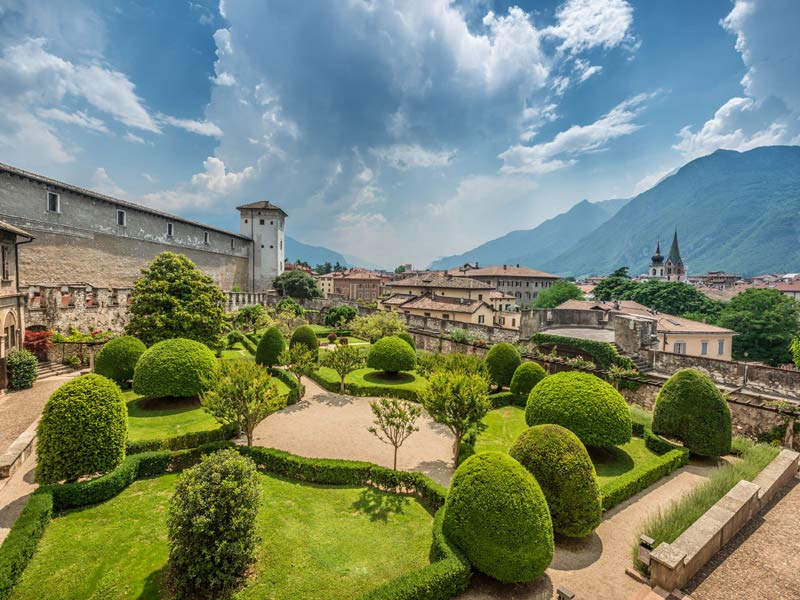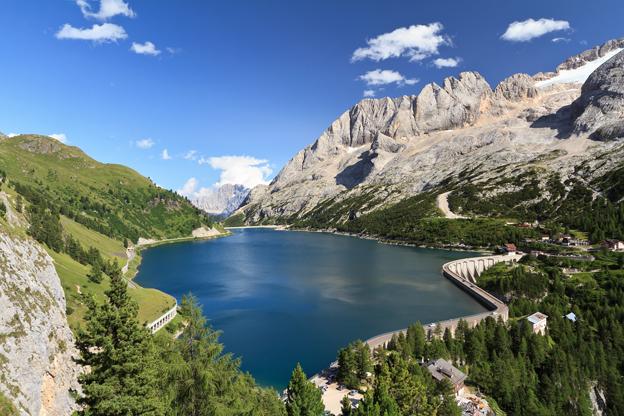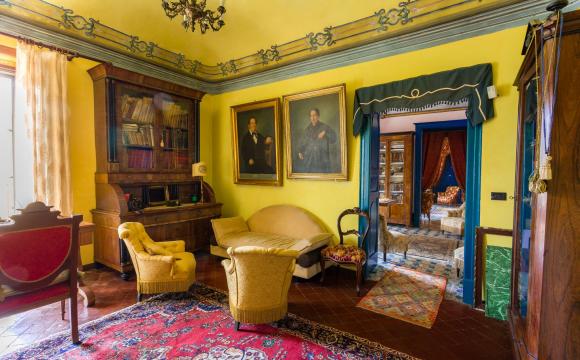Trentino was twinned with its northern neighbour Alto Adige in 1948 to create a single region, a land of refreshingly unspoilt parks full of wildlife, castles set in glorious landscape, dramatic mountains and lakes – it even has its own small share of Lake Garda. At the centre of this little-known corner of Italy lies the main city of Trento, while to the southeast and east it is bordered by the Veneto and to the west it adjoins Lombardy.
It is less Tyrolean in character than the mainly German-speaking Alto Adige and very much looks to Italy for its language and culture. After the First World War, when the whole region became part of Italy, Alto Adige continued to hang onto its Germanic language and culture, while Trentino rapidly adjusted to its new Italian status. It is a rural area where outdoor life is highly-prized and traditional ways of life continue, as seen in September when visitors can still witness the time-honoured spectacle of the herds returning from the summer pastures adorned with flowers and surrounded by dancing, music and food. Cheese is an important part of local food production and cheese-making demonstrations are held around this time as well. Caldonazzo, Valsugana and Primero are good places to witness these autumnal festivities.
The two main cities lie in the Val Lagarina which follows the course of the Adige River, but, rural though this region might be, the towns and cities are sophisticated and inviting. Steeped in history and having a long connection with the arts, Trento’s main claim to fame was the Council of Trent held between 1545 and 1563 at the mid-point between the worlds of Italy and the Teutonic culture to the north. This wasn’t just a UK-style political party conference, but a serious attempt to resolve a crisis in the Catholic world under threat from Lutherism and Calvinism and create a more modern, enlightened Catholic church. The Piazza del Duomo, as always in Italy, is the heart of this graceful city and it was in the Romanesque Duomo, as well as the nearby Church of Santa Maria Maggiore, that the famous council took place. At the centre of the piazza is the Fontana del Nettuno, Neptune’s Fountain, from where you can admire a graceful array of buildings, in particular the two richly-frescoed Cazuffi-Rella buildings, the 41-metre-high Torre Civica and the 12th-century Piazza Pretorio housing a museum with paintings of the Council of Trent in session.

Behind the Duomo in Piazza Adamo d’Aragno and along Via Carlo Esterle, there is a well-known and very colourful market held on Thursdays where you can easily become intoxicated by the wide range of cheeses and other local produce. The area is famous for its fruit production, especially the fragrant Val di Non apples.
Mushrooms are highly-prized ingredients of the Trentino kitchen and in Piazza Lodron there is a market largely devoted to funghi (mushrooms) with over 250 varieties available in the main season. All around the city you will find a wide range of tempting food shops; look out for polenta, the chief element of Trentino cooking, but varying in colour and texture according to the region and time of year.
Shops selling seductive desserts are also very hard to ignore as is the ice cream for which the town is famous. Of course, Trento also has a good selection of restaurants as well as bars like the Caffè Portici in the Piazza del Duomo, where you can watch the world go by from one of the pleasant outdoor tables. To sample local cuisine in a charming family restaurant ambience, try the small Locanda Port’Aquila in Via Cervara.
Those with an interest in modern art will want to visit the newly-opened Mart Museum, housed in a stunning modern building by the river and to the west of the Duomo (the main museum is in nearby Rovereto).
Another building that deserves a visit is the imposing Castello del Buonconsiglio, once the residence of a line of bishop princes dating back to the Middle Ages. Rebuilt in Gothic Venetian style, it contains a fine frescoed portico, a provincial art museum and the excellent Torre dell’Aquila which contains intriguing 15th-century frescoes named Ciclo dei Mesi – ‘The Cycle of the Months’, illustrating contemporary rural life that repay close study. From the balcony you get a wonderful view of the city and surrounding Alpine landscape. To experience this dramatic Dolomite scenery at closer quarters, it is well worth driving up to Monte Bondone reached by a zigzagging road that takes you up to a stunning panorama of an area abundant in wildlife and popular for winter sports. There is an Alpine Botanical Garden here, but this is also a wonderful spot to admire the landscape at the end of the day, just before sunset.

More than second best
Just south of Trento and surrounded by vineyards is the region’s second city of Rovereto, once an outpost of the Venetian Empire - a city that is proud of its cultural heritage yet seldom visited by tourists, even though the streets are lined with beautiful palaces and other fine medieval and Renaissance buildings.
It was here that a 13-year-old Mozart gave his first concert in Italy and the building he visited in Via Mercerie became established as the Associazione Mozart Italia.
The musical tradition extends further as this was the birthplace of the opera composer Riccardo Zandonai and there is a beautiful little theatre dedicated to him on Corso Angelo Bettini. However, one of the most noticeable features of Rovereto and its surroundings is the number of memorials dedicated to the soldiers who gave their lives in the First World War and other European conflicts. The Sentiero della Pace or ‘Peace Trail’, has been established following the front lines where, in the winter of 1916 alone, more than 10,000 soldiers died. A famous local landmark is the Campana dei Caduti, made from melted-down cannon as well as the sombre circular monument to the WWI dead.
Water, water everywhere

Even though Trentino has no coastline, any map of the area shows that there is no shortage of water in the region. I am assured that there are 297 lakes altogether, covering an area of 35 square kilometres. Many of them are at a height of above 1,500 metres and are created from glacial incisions. Just north of Garda, Lago di Cavedine creates hydroelectric power but is nevertheless a peaceful area to enjoy an otherwise unspoilt natural habitat. East of Trento is Lago di Caldonazzo, a squeaky-clean environment popular for watersports with a free beach and the only lake to allow water-skiing. West of Rovereto, passing through more vineyards and neat rows of fruit trees is Italy’s largest area of inland water, Lake Garda, where Trentino’s small window on to the lake (Veneto and Lombardy have the main shares) is centred around the popular resort of Riva del Garda. Here steep mountains drop down to the water’s edge and, although Alpine, the area is warm enough to grow olives and some particularly fine olive oil is made here by small producers. The waterfront of the attractive, colourful town is dominated by the stern Rocca di Riva, a medieval moated fortress reached by drawbridge. A stylish resort since the 19th-century, it is a busy place in the short summer season as well as on any fine weekends, even in deepest winter. It is a popular centre for water sports or just to walk around the shops of the old town or perhaps enjoy a drink at an outdoor table on the lake front.
Innumerable wonders

To the northeast of the provincial capital is the beautiful Val di Fiemme where you will find Cavalese, one of the most popular skiing resorts in Trentino, but also worth visiting in spring when the slopes are a mass of wildflowers.
In the centre of town you cannot fail to notice the most impressive building, the frescoed Palazzo della Magnifica Comunità, which was the Bishop of Trento’s summer palace. Further up the valley is Canazei, an Alpine village providing a good base for exploring some of the best of the Dolomites, possibly climbing in the Marmolada range - which reaches a height of 3,342 metres - or skiing in the Sella area around Pordoi.
Northwest of Trento is the Brenta range which offers some of the most famous of Trentino’s mountain scenery, such as around Madonna di Campiglio, a stylish ski resort, second only to Cortina d’Ampezzo.
All around this magnificent landscape are numerous castles and forts built over the ages to protect a border region that was always vulnerable to attack. These days, many have been restored to become cultural centres where you would go to taste wine or view an art exhibition rather than to honour an appointment with the local executioner. Castel d’Avio was built to protect a valuable trading routes to the Mediterranean. The largest, Castel Beseno, is situated in a dramatic location and seems to cover an entire hilltop above the Trento road north of Rovereto.
With so many other towns, lakes and mountain ranges that have not been mentioned, it is clear that with an area as rich as this you cannot appreciate fully what is on offer without staying a while. It is an easy drive here from the Adriatic coast and a detour to quiet Trentino makes an ideal additional destination during a visit to the tourist’s mecca of Venice.




